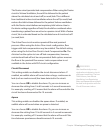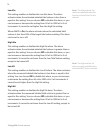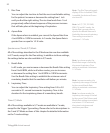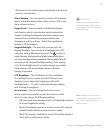Chapter 5 Viewing and Changing Settings
81
2. IPAP
The IPAP setting displays if AVAPS is O. You can increase or
decrease the Inspiratory Positive Airway Pressure (IPAP) from 4
to 50 cm H
2
O in increments of 1. IPAP is limited to a maximum of
25 cm H
2
O when Flex is enabled. You cannot set the IPAP setting
lower than the EPAP setting.
3. IPAP Max Pressure
The IPAP Max Pressure setting displays if AVAPS is enabled.
You can increase or decrease the setting from 4 to 50 cm H
2
O
in increments of 1. The IPAP Max Pressure must be equal to or
greater than the IPAP Min value.
4. IPAP Min Pressure
The IPAP Min Pressure setting displays if AVAPS is enabled.
You can increase or decrease the setting from 4 to 50 cm H
2
O
in increments of 1. The IPAP Min Pressure must be equal to or
greater than the EPAP value, and it must be less than or equal to
the IPAP Max Pressure.
5. EPAP
You can increase or decrease the Expiratory Positive Airway
Pressure (EPAP) from 4 to 25 cm H
2
O in increments of 1. For
active circuits, EPAP can be set to zero.
When AVAPS is disabled, the EPAP setting must be less than
or equal to the IPAP setting. When AVAPS is enabled, the EPAP
pressure must be less than or equal to the IPAP Min Pressure.
6. Tidal Volume
The Tidal Volume setting displays if AVAPS is enabled. You can
increase or decrease the setting from 50 to 2000 ml in 5 ml
increments. Use this setting to establish the target volume of
gas which the ventilator will produce and deliver during each
Spontaneous breath.
Note: IPAP, IPAP Max, or IPAP
Min cannot be set to more than
30 cm H
2
O above EPAP.
Note: EPAP cannot be set to
more than 30 cm H
2
O below
IPAP, IPAP Max, or IPAP Min.
Note: In CV, AC, and SIMV
modes, the tidal volume setting
is limited by the Inspiratory
Time, to maintain the system’s
minimum and maximum peak
ows.


















